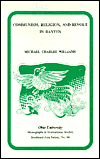

 |

|

The average rating for Communism, Religion, and Revolt in Banten in the Early Twentieth Century based on 2 reviews is 3 stars.
Review # 1 was written on 2010-08-22 00:00:00 Daniel Masters Daniel MastersThis book is an extrordinary look at the history of Iran, from the Constitutional Revolution of 1906, through and including the election of Mahmoud Ahmadinejad in 2005. "Democracy in Iran" picks up where "The Turban for the Crown" leaves off. The authors present a thorough academic and educated analysis of historical events in Iran. Yet they take it a step further by analyzing the philosophy, thought process, and politics of Iran's respective leaders and population at large. The text of the book is comprised of 158 pages, but don't be fooled by its brevity: you will invest as much time in reading and thinking about it as you will a book of twice the length and heft. I have read through it within the space of this weekend, and have stuck myriad post-its throughout my library borrowed copy. After the read through and realizing that I'll want to refer to many passages again, I bought a copy to download onto the Nook, and highlighted all of the "post-it" references. I feel like I just took a graduate level course in reading "Democracy in Iran," in the most positive sense. I now have a working knowledge of Iranian history, which will be of use when I return to school in the fall. |
Review # 2 was written on 2011-04-26 00:00:00 David Rayolson David RayolsonThe first things you notice about this book is that it is not an easy read. It is a seriously researched and well written book which chronicles the progress of 'democracy' in Iran. Being someone interested in geopolitics and history, it was a very educational book for me. From the revolution in early 20th century to the changes in early 21st century, you see a complete change in the way religion and the clergy class are related to the power structure; going from being at least partially dependent on the kings for protection (and who in turn provided legitimacy to the kings) to being the rulers who abolished monarchy. It is in the end a fascinating look at how democracy in Iran has evolved over last century while dealing with state building and role of religion in society. One positively surprising thing was also learning how many words in Indian languages have Farsi/Arabic roots and some of which are part of official English Dictionary. |
CAN'T FIND WHAT YOU'RE LOOKING FOR? CLICK HERE!!!